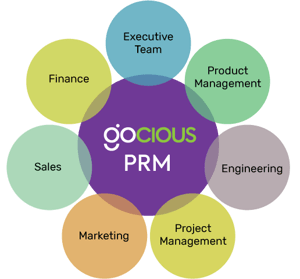Your product roadmap is an essential part of the manufacturing process. It guides production while defining the product vision from conception to development. Product manufacturing can be a complex process. If you consider the design and engineering of a vehicle, many components come into play. There is a product team in place for each feature of a vehicle, from the engine, tires, frame, and brakes to the axles, gears, seating, electrical, and lighting to the product software. The only way to manage all these moving pieces is to have a roadmap and a strategy to manage it.

The Benefits of a Product Roadmap Management Strategy
 When creating a roadmap for your product, you’re going to be setting objectives that you want to achieve during the development process, production, and once the product is launched. These objectives should align with your company’s vision and goals. An effective product roadmap will be aligned with the company goals from the start.
When creating a roadmap for your product, you’re going to be setting objectives that you want to achieve during the development process, production, and once the product is launched. These objectives should align with your company’s vision and goals. An effective product roadmap will be aligned with the company goals from the start.
As you manage your roadmap, you’ll be tracking several KPIs as you go along to ensure that your product is progressing as planned. Knowing your data and tracking against your objectives will help you course-correct when necessary, adjust your roadmap if needed, and have a clear understanding of the roadmap trajectory.
Having a tactical strategy for managing your roadmap and the right tools in place can make a dramatic difference for your teams too. Not only will you be able to monitor your key metrics, but you’ll be able to share and analyze the data with your teams.
1. Hold Better Consultations and Cross-Functional Meetings
 Following a product management strategy requires communication and meetings between departments. Here are things to consider if you need to improve your consultations.
Following a product management strategy requires communication and meetings between departments. Here are things to consider if you need to improve your consultations.
Who Do You Need to Meet With?
It's important that you meet with all departments, from marketing to finance to engineering and any team that has a hand in contributing to product development. When you understand the potential issues they face, it makes it easier to manage problems as and when they arise.
Regular Check-Ins are Essential
Even the best-laid plans are not immune to external forces. Supply chain issues can result in delays for parts, in effect stalling the entire production process and causing a product backlog. Regular check-ins and updates ensure that such issues can be identified early and that steps can be taken to mitigate the problem.
Cross-Functional Meetings
Regular meetings with each team help to relay information, keep you apprised of team progress and identify potential problems. Cross-functional meetings with representatives from several departments also assist with problem-solving and innovation.
Consider the Customer success team. They provide customer feedback that would be useful for the design and engineering teams. In the case of a vehicle, this feedback might guide whether importance should be placed on one feature over another. Collaboration between these teams would result in a superior product being built.
Increasing interaction between departments also promotes stronger relationships and a common focus on wider business goals.
2. Share the Vision of the Product and the Goals Clearly Across Teams
 Clearly defined goals help to ensure that everyone is on the same page. Your job as the product manager is to promote the vision of the company to all of your product teams.
Clearly defined goals help to ensure that everyone is on the same page. Your job as the product manager is to promote the vision of the company to all of your product teams.
For a car manufacturer, the goal might be to convert to a fully electric portfolio of vehicles by 2035. This goal helps engineers to focus on the technology to make this possible so that each product launch gets the company closer to its goal.
Your product roadmap is your single source of truth that extends across the entire company. Ensuring that it is accessible to all stakeholders and that they use the platform proactively will support your management strategy.
Utilize Collaborative Tools
Shared documents, reports, and analytical features allow information to pass easily between your cross-functional teams. A key feature of cloud-based PRM software is that the information is up-to-date and easily accessible. This is ideal for personnel who may be working from a remote location.
Communicating the goals also requires you to use the roadmap consistently. Assess and update any changes to the product goals in order to promote and maintain alignment across the company.
3. Use Your Product Roadmap Management Tools Effectively
 Product roadmaps are dynamic, which is why agile tools are beneficial to your overall strategy. Everyone sees the information displayed in the management software when your teams share regular updates.
Product roadmaps are dynamic, which is why agile tools are beneficial to your overall strategy. Everyone sees the information displayed in the management software when your teams share regular updates.
As the environment changes, so too can the roadmap, and with your teams working collaboratively across the platform.
Define Your Long-Term Goals
While having short-term goals is essential to getting a product built and launched, a long-term strategy is vital to consider changes in the market. Technology and innovation are constantly evolving, so having a clear understanding of where you want to be in five, ten, or fifteen years is an essential part of any roadmap.
Product roadmap management tools give you the agility to help you adapt to your changing needs. While research analysts try to forecast and make predictions, the market is inevitably subject to change. Gocious PRM software allows you to define and detail your goals over time. As the landscape evolves, you adjust the plan in order to reflect the required changes.
Competitive Analysis Tools
 The competitive analysis tool in the Gocious PRM software assists in strategizing and planning for different scenarios. For example, what would be the effect of adding or removing a product feature? What is the impact on cost, market share, and projected revenues? Using this tool, you can tailor your response easily and quickly for different departments.
The competitive analysis tool in the Gocious PRM software assists in strategizing and planning for different scenarios. For example, what would be the effect of adding or removing a product feature? What is the impact on cost, market share, and projected revenues? Using this tool, you can tailor your response easily and quickly for different departments.
How Does Your Product Stack Up Against That of a Competitor?
Gocious PRM software also has a comparative analysis between competitor products that helps you assess what you are doing right and where you may be falling short. This information is important in guiding your strategy for product development, both in the short and long term.
How to Find the Best Product Roadmap Management Software for Your Company
When selecting a product roadmap management software for your company, several factors come into play.
- What is the potential return on investment for your company?
- Does the software allow you to create different roadmaps for different stakeholders and over different timelines?
- Does the software make cross-functional collaborations more effective and efficient?
- Does the software help you manage your entire product portfolio as well as each product in detail?
Product Roadmap Management Software for Manufacturers
Gocious Product Roadmap Software is designed specifically with the product manufacturing process in mind. It provides a key reference point from which all teams gain perspective and work collaboratively. Gocious PRM software does all this and more. Manage, monitor, analyze and share from one easy-to-use software application. Book your free demo to see how Gocious can work for your company.



